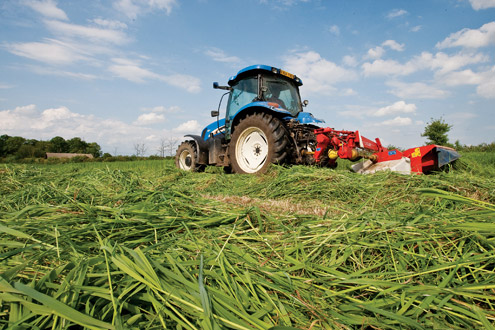Don’t be tempted to delay first-cut silage

Producers inclined to wait for a later, bulky first cut to replenish forage stocks should avoid temptation and instead cut when grass is at its optimum to maintain long-term performance.
Extended housing and escalating feed costs means the emphasis for the rest of the season will very much be on restocking silage clamps and trying to get more milk or performance from forage.
However, to do this, the grass plant needs to be stimulated for rapid regrowth and regeneration, explains Frank Wright ruminant manager Adam Clay.
“I’m concerned farmers will leave the crop to mature and cut late in order to get high yields.” However, he says this could affect future cuts.
Using the Midlands and south of England as an example, Mr Clay says if grass crops are harvested later in June, producers will hit a period when growth rates will stop. Consequently, recovery rates could be compromised, potentially hitting second and third cuts.
By cutting earlier, farmers could use the high growth rates seen at the end of May to replenish fields harvested for first cut.
“If you leave too late, you will get a bulkier first cut, but you’ll see reduced tonnage at second cut. All the figures show if you make an early, low-yielding first cut, second cut will be higher tonnage.
“The main message is, don’t panic and try and fill reserves in one go – play the long game,” he says.
Leaving grass to grow longer will also compromise quality, increasing neutral detergent fibre (NDF), but proportionally reducing metabolisable energy (ME) and digestibility. This in turn will negatively affect quality and performance.
This was shown in first-cut silage quality results from 2012, when many silage dates were delayed because of the weather. On average 2012 first cuts were 11.1ME compared to 11.3ME in 2011.
While this may seem like a small difference, with intakes of 12kg DM a head a day over a 150-day winter, the increased quality of the 2011 crop equates to 69 extra litres of milk a cow over the winter.
“This is worth £20 a cow for each winter or £2,000 for a 100-cow herd at a 29p/litre milk price,” says Mr Clay.
For optimum quality and quantity, ideally grass should be cut when it exceeds grazing length and measures 3,200kg DM/ha when using a grass plate meter.
However, DairyCo extension officer Piers Badnell stresses the decision of when to cut should always be made on stage of grass growth rather than a set date.
“I reckon heading dates could be about seven to 10 days later on average than usual. For maximum quality you want to cut just before the emergence of the seed head. Go out and look at your grass, split it down the middle and see where the seed head is,” he says.
Mr Badnell also believes if ever there’s a year to test for free nitrates in grass prior to cutting, this is it.
“This year we don’t know how much nitrogen uptake there’s been because of the cold weather and we don’t know how much has been washed away,” he says.
Emma Thompson, Promar principal consultant, agrees. “Before first cut you want to see free nitrates are at their lowest level, otherwise they will cause buffering in the clamp,” she says.
“This will stop pH from dropping quickly and could cause problems with secondary fermentation, reducing palatability, intakes and quality.”
Mr Clay also says last year’s wet season demonstrated the importance of reducing soil contamination at cutting to maintain fermentation and quality. Ideally producers should leave 5-7cm of grass after cutting.
